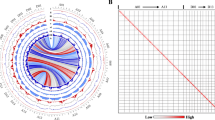Abstract
The genetic base in Upland cotton (Gossypium hirsutum L.) is narrow. Repeated random mating through generations during germplasm development may be an appealing approach to introgress desirable genes from exotic germplasm into Upland cotton. A random mating population, MDRM, was developed to provide a source of germplasm with introgression of novel alleles from other tetraploid species. This population was derived from 48 crosses between four Upland cotton lines/cultivars (MD15, MD52ne, and TAM98D-99ne and FiberMax832) as female parents and twelve exotic germplasm lines as male parents. The male parents include six lines derived from multiple crosses between G. hirsutum and G. barbadense L. and another six lines derived from multiple crosses among five Gossypium tetraploid species. After five generations of random mating followed by six generations of self-pollination, the bulk of RM5F7 population was produced, which further led to the development of recombinant inbred lines (RILs) from seed increase of single plants in the bulk. The bulk of RM5F7 and its 276 RILs were evaluated along with 134 RM0F7 RILs (0 generation of random mating) and 142 RM1F7 RILs (1 generation of random mating) and the parents at College Station, TX, Las Cruces, NM, and Stoneville, MS from 2016 to 2022. The bulk of RM5F7 has superior fiber quality with acceptable yield as compared with parents. Transgressive segregation was observed in RM5F7 RILs for both lint yield and fiber quality. Unfavorable associations between yield and fiber properties of length, strength, and uniformity in RM5F7 were reduced compared with RM0F7 or RM1F7. Therefore, MDRM provides a new breeding stock for cotton breeders to develop germplasm lines with desirable combinations between lint yield and fiber quality and unique combinations of alleles from exotic parents.
Similar content being viewed by others
Abbreviations
- LP:
-
Lint percentage
- UHML:
-
Upper half mean length
- Str:
-
Strength
- UI:
-
Uniformity index
- EL:
-
Elongation
- MIC:
-
Micronaire
- RIL:
-
Recombinant inbred line
- RM:
-
Random mating
References
Clement JD, Constable GA, Stiller WN, Liu SM (2012) Negative associations still exist between yield and fibre quality in cotton breeding programs in Australia and USA. Field Crop Res 128:1–7
Esbroeck GV, Bowman DT (1998) Cotton germplasm diversity and its importance to cultivar development. J Cotton Sci 2:121–129
Hanson WD (1959) The breakup of initial linkage blocks under selected mating systems. Genetics 44:857–868
Hinze LL, Campbell BT, Kohel R (2011) Performance and combining ability in cotton (Gossypium hirsutum L.) populations with diverse parents. Euphytica 181:115–125
Hinze LL, Kohel RJ, Campbell BT, Percy RG (2014) Registration of four diverse random-mated cotton germplasm populations. J Plant Regist 8:57–62
Jenkins JN, McCarty JC, Gutierrez OA, Hayes RW, Bowman DT, Watson CE, Jones DC (2008) Registration of RMUP-C5, a random mated population of Upland cotton germplasm. J Plant Regist 3:239–242
McCarty JC, Jenkins JN, Wu J (2005) Primitive accession derived germplasm by cultivar crosses as sources for cotton improvement. Crop Sci 44:1231–1235
McClosky B, Tanksley SD (2013) The impact of recombination on short-term selection gain in plant breeding experiments. Theor Appl Genet 126:2299–2312
Meredith WR, Bridge RR (1971) Breakup of linkage blocks in cotton, Gossypium hirsutum L. Crop Sci 11:695–698
Miller PA, Rawlings JO (1967) Breakup of initial linkage blocks through inter-mating in a cotton breeding program. Crop Sci 7:199–204
SAS Institute (2012) SAS/STAT. User’s guide. Version 9.4. SAS Inst., Cary, NC
Thaxton PM, Smith CW, Cantrell R (2005) Registration of TAM 98D-102 and TAM 98D-99ne upland cotton germplasm lines with high fiber strength. Crop Sci 45:1668–1669
Zeng L, Meredith WR Jr (2009a) Associations among lint yield, yield components, and fiber properties in an introgressed population of cotton. Crop Sci 49:1647–1654
Zeng L, Meredith WR Jr (2009b) Registration of five exotic germplasm lines of cotton derived from multiple crosses among Gossypium tetraploid species. J Plant Regist 3:77–80
Zeng L, Meredith WR, Boykin DL, Taliercio E (2007) Evaluation of an exotic germplasm population derived from multiple crosses among Gossypium tetraploid species. J Cotton Sci 11:118–127
Zeng L, Meredith WR Jr, Campbell BT (2010) Registration of four exotic germplasm lines derived from an Introgressed Population of Cotton. J Plant Regist 4:240–243
Acknowledgements
This research was funded by USDA-ARS, Project No. 6066-21000-052-00D, 6054-21000-018-00D, 6054-44000-080-00-D, and 3091-21000-041-000D.
USDA is an equal opportunity provider and employer.
The findings and conclusions in this publication are those of the authors and should not be construed to represent any official USDA or U.S. Government determination or policy.
Funding
The authors have not disclosed any funding.
Author information
Authors and Affiliations
Contributions
The author LZ wrote the main manuscript text and prepared all tables. All authors contributed to the development of concepts, experiment planning, and design. Authors of LZ, LH, and JZ conducted trials. All authors contributed to the data analysis and explanation of results. All authors reviewed the manuscript, revised and approved the manuscript.
Corresponding author
Ethics declarations
Conflict of interest
The authors declare no competing interests.
Additional information
Publisher’s Note
Springer Nature remains neutral with regard to jurisdictional claims in published maps and institutional affiliations.
Mention of trade names or commercial products in this publication is solely for the purpose of providing specific information and does not imply recommendation or endorsement by the U.S. Department of Agriculture.
Rights and permissions
About this article
Cite this article
Zeng, L., Hinze, L., Fang, D.D. et al. Analysis of a cotton introgression population derived through multiple generations of random mating in multiple-parents crosses. Euphytica 219, 101 (2023). https://doi.org/10.1007/s10681-023-03213-1
Received:
Accepted:
Published:
DOI: https://doi.org/10.1007/s10681-023-03213-1




